International Business Analysis of Amazon: India Market Entry Strategy
VerifiedAdded on 2022/08/28
|12
|3700
|21
Essay
AI Summary
This essay provides a comprehensive analysis of Amazon's international business operations, with a specific focus on its ventures in India. The analysis begins with a brief profile of Amazon, highlighting its origins, evolution, and key competencies, including its customer-centric approach, delivery and logistics capabilities, and the development of closed ecosystems. The essay then delves into Amazon's expansion into India, examining the market entry strategy, the challenges faced, and the company's attempts to adapt to the local market conditions and regulations. The essay discusses the cultural differences between India and the United States, and how these differences impact Amazon's strategies. Furthermore, it explores the competitive landscape, the impact of local e-commerce firms, and the influence of government regulations on Amazon's operations. The essay also examines the company's strategic advantages, such as its Prime membership program, and its ability to provide free and fast shipping options. Finally, the essay addresses the threats and opportunities Amazon faces in the Indian market, considering the evolving regulatory environment and the company's long-term ambitions in the country.
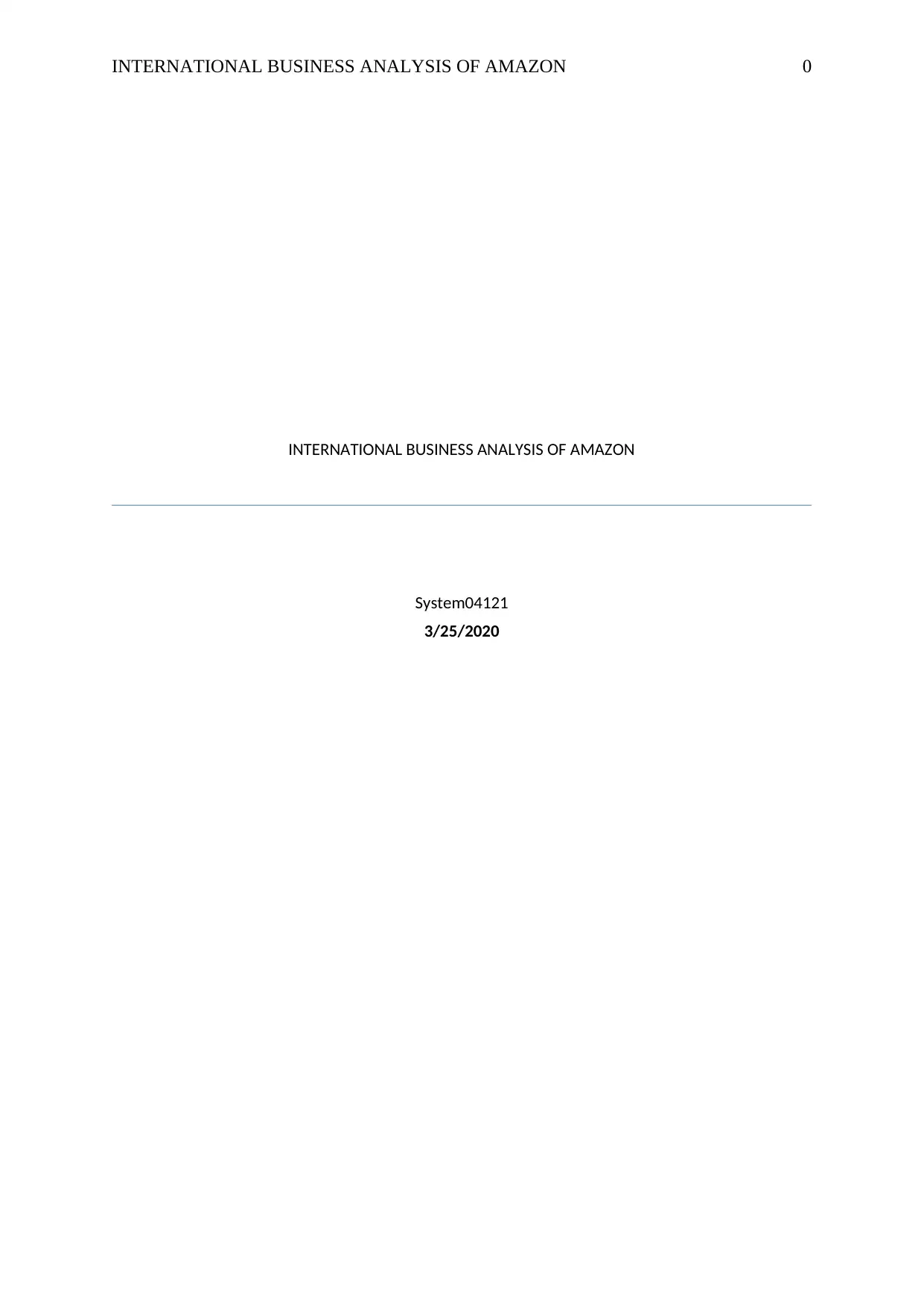
INTERNATIONAL BUSINESS ANALYSIS OF AMAZON 0
INTERNATIONAL BUSINESS ANALYSIS OF AMAZON
System04121
3/25/2020
INTERNATIONAL BUSINESS ANALYSIS OF AMAZON
System04121
3/25/2020
Paraphrase This Document
Need a fresh take? Get an instant paraphrase of this document with our AI Paraphraser
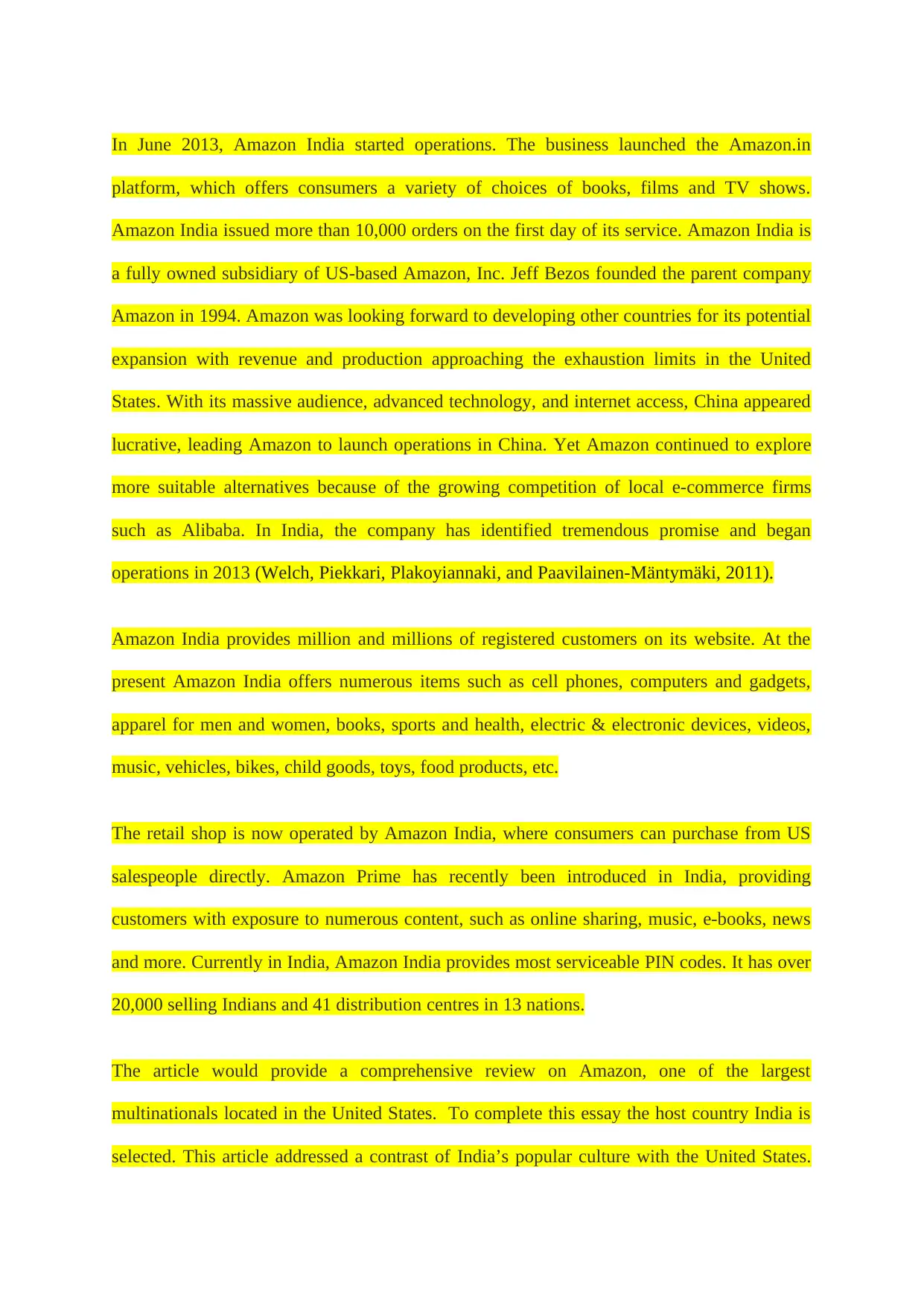
In June 2013, Amazon India started operations. The business launched the Amazon.in
platform, which offers consumers a variety of choices of books, films and TV shows.
Amazon India issued more than 10,000 orders on the first day of its service. Amazon India is
a fully owned subsidiary of US-based Amazon, Inc. Jeff Bezos founded the parent company
Amazon in 1994. Amazon was looking forward to developing other countries for its potential
expansion with revenue and production approaching the exhaustion limits in the United
States. With its massive audience, advanced technology, and internet access, China appeared
lucrative, leading Amazon to launch operations in China. Yet Amazon continued to explore
more suitable alternatives because of the growing competition of local e-commerce firms
such as Alibaba. In India, the company has identified tremendous promise and began
operations in 2013 (Welch, Piekkari, Plakoyiannaki, and Paavilainen-Mäntymäki, 2011).
Amazon India provides million and millions of registered customers on its website. At the
present Amazon India offers numerous items such as cell phones, computers and gadgets,
apparel for men and women, books, sports and health, electric & electronic devices, videos,
music, vehicles, bikes, child goods, toys, food products, etc.
The retail shop is now operated by Amazon India, where consumers can purchase from US
salespeople directly. Amazon Prime has recently been introduced in India, providing
customers with exposure to numerous content, such as online sharing, music, e-books, news
and more. Currently in India, Amazon India provides most serviceable PIN codes. It has over
20,000 selling Indians and 41 distribution centres in 13 nations.
The article would provide a comprehensive review on Amazon, one of the largest
multinationals located in the United States. To complete this essay the host country India is
selected. This article addressed a contrast of India’s popular culture with the United States.
platform, which offers consumers a variety of choices of books, films and TV shows.
Amazon India issued more than 10,000 orders on the first day of its service. Amazon India is
a fully owned subsidiary of US-based Amazon, Inc. Jeff Bezos founded the parent company
Amazon in 1994. Amazon was looking forward to developing other countries for its potential
expansion with revenue and production approaching the exhaustion limits in the United
States. With its massive audience, advanced technology, and internet access, China appeared
lucrative, leading Amazon to launch operations in China. Yet Amazon continued to explore
more suitable alternatives because of the growing competition of local e-commerce firms
such as Alibaba. In India, the company has identified tremendous promise and began
operations in 2013 (Welch, Piekkari, Plakoyiannaki, and Paavilainen-Mäntymäki, 2011).
Amazon India provides million and millions of registered customers on its website. At the
present Amazon India offers numerous items such as cell phones, computers and gadgets,
apparel for men and women, books, sports and health, electric & electronic devices, videos,
music, vehicles, bikes, child goods, toys, food products, etc.
The retail shop is now operated by Amazon India, where consumers can purchase from US
salespeople directly. Amazon Prime has recently been introduced in India, providing
customers with exposure to numerous content, such as online sharing, music, e-books, news
and more. Currently in India, Amazon India provides most serviceable PIN codes. It has over
20,000 selling Indians and 41 distribution centres in 13 nations.
The article would provide a comprehensive review on Amazon, one of the largest
multinationals located in the United States. To complete this essay the host country India is
selected. This article addressed a contrast of India’s popular culture with the United States.
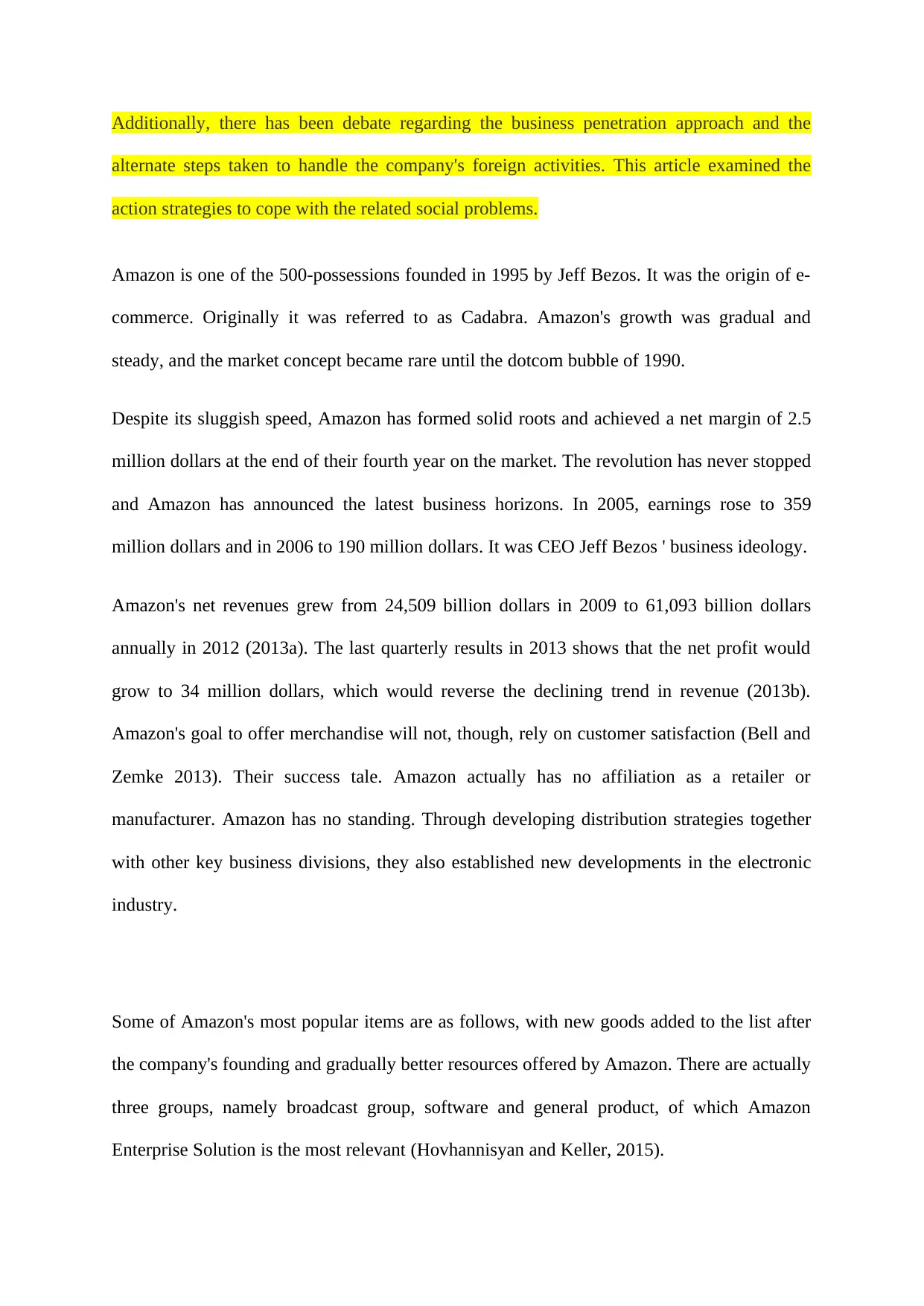
Additionally, there has been debate regarding the business penetration approach and the
alternate steps taken to handle the company's foreign activities. This article examined the
action strategies to cope with the related social problems.
Amazon is one of the 500-possessions founded in 1995 by Jeff Bezos. It was the origin of e-
commerce. Originally it was referred to as Cadabra. Amazon's growth was gradual and
steady, and the market concept became rare until the dotcom bubble of 1990.
Despite its sluggish speed, Amazon has formed solid roots and achieved a net margin of 2.5
million dollars at the end of their fourth year on the market. The revolution has never stopped
and Amazon has announced the latest business horizons. In 2005, earnings rose to 359
million dollars and in 2006 to 190 million dollars. It was CEO Jeff Bezos ' business ideology.
Amazon's net revenues grew from 24,509 billion dollars in 2009 to 61,093 billion dollars
annually in 2012 (2013a). The last quarterly results in 2013 shows that the net profit would
grow to 34 million dollars, which would reverse the declining trend in revenue (2013b).
Amazon's goal to offer merchandise will not, though, rely on customer satisfaction (Bell and
Zemke 2013). Their success tale. Amazon actually has no affiliation as a retailer or
manufacturer. Amazon has no standing. Through developing distribution strategies together
with other key business divisions, they also established new developments in the electronic
industry.
Some of Amazon's most popular items are as follows, with new goods added to the list after
the company's founding and gradually better resources offered by Amazon. There are actually
three groups, namely broadcast group, software and general product, of which Amazon
Enterprise Solution is the most relevant (Hovhannisyan and Keller, 2015).
alternate steps taken to handle the company's foreign activities. This article examined the
action strategies to cope with the related social problems.
Amazon is one of the 500-possessions founded in 1995 by Jeff Bezos. It was the origin of e-
commerce. Originally it was referred to as Cadabra. Amazon's growth was gradual and
steady, and the market concept became rare until the dotcom bubble of 1990.
Despite its sluggish speed, Amazon has formed solid roots and achieved a net margin of 2.5
million dollars at the end of their fourth year on the market. The revolution has never stopped
and Amazon has announced the latest business horizons. In 2005, earnings rose to 359
million dollars and in 2006 to 190 million dollars. It was CEO Jeff Bezos ' business ideology.
Amazon's net revenues grew from 24,509 billion dollars in 2009 to 61,093 billion dollars
annually in 2012 (2013a). The last quarterly results in 2013 shows that the net profit would
grow to 34 million dollars, which would reverse the declining trend in revenue (2013b).
Amazon's goal to offer merchandise will not, though, rely on customer satisfaction (Bell and
Zemke 2013). Their success tale. Amazon actually has no affiliation as a retailer or
manufacturer. Amazon has no standing. Through developing distribution strategies together
with other key business divisions, they also established new developments in the electronic
industry.
Some of Amazon's most popular items are as follows, with new goods added to the list after
the company's founding and gradually better resources offered by Amazon. There are actually
three groups, namely broadcast group, software and general product, of which Amazon
Enterprise Solution is the most relevant (Hovhannisyan and Keller, 2015).
⊘ This is a preview!⊘
Do you want full access?
Subscribe today to unlock all pages.

Trusted by 1+ million students worldwide
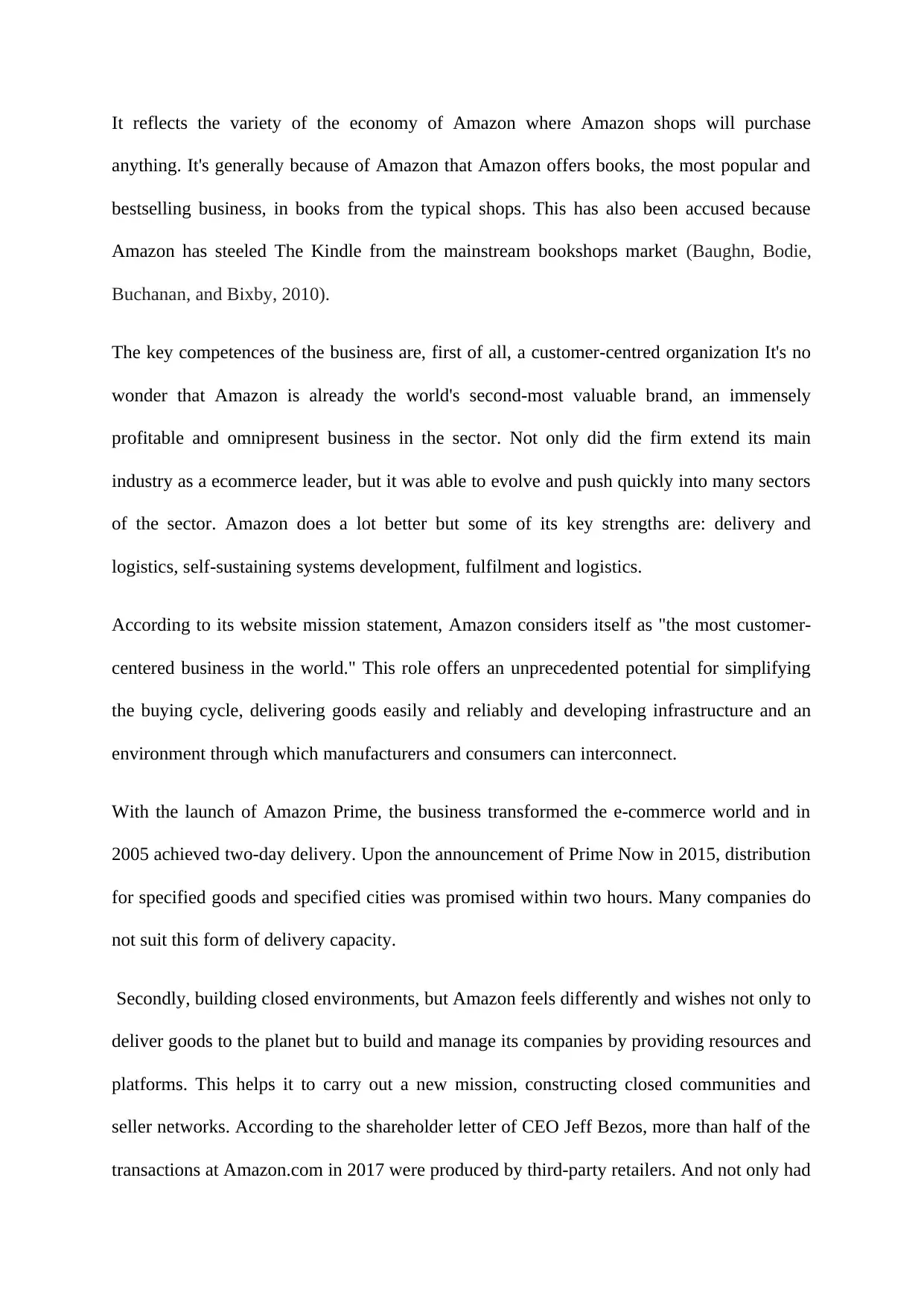
It reflects the variety of the economy of Amazon where Amazon shops will purchase
anything. It's generally because of Amazon that Amazon offers books, the most popular and
bestselling business, in books from the typical shops. This has also been accused because
Amazon has steeled The Kindle from the mainstream bookshops market (Baughn, Bodie,
Buchanan, and Bixby, 2010).
The key competences of the business are, first of all, a customer-centred organization It's no
wonder that Amazon is already the world's second-most valuable brand, an immensely
profitable and omnipresent business in the sector. Not only did the firm extend its main
industry as a ecommerce leader, but it was able to evolve and push quickly into many sectors
of the sector. Amazon does a lot better but some of its key strengths are: delivery and
logistics, self-sustaining systems development, fulfilment and logistics.
According to its website mission statement, Amazon considers itself as "the most customer-
centered business in the world." This role offers an unprecedented potential for simplifying
the buying cycle, delivering goods easily and reliably and developing infrastructure and an
environment through which manufacturers and consumers can interconnect.
With the launch of Amazon Prime, the business transformed the e-commerce world and in
2005 achieved two-day delivery. Upon the announcement of Prime Now in 2015, distribution
for specified goods and specified cities was promised within two hours. Many companies do
not suit this form of delivery capacity.
Secondly, building closed environments, but Amazon feels differently and wishes not only to
deliver goods to the planet but to build and manage its companies by providing resources and
platforms. This helps it to carry out a new mission, constructing closed communities and
seller networks. According to the shareholder letter of CEO Jeff Bezos, more than half of the
transactions at Amazon.com in 2017 were produced by third-party retailers. And not only had
anything. It's generally because of Amazon that Amazon offers books, the most popular and
bestselling business, in books from the typical shops. This has also been accused because
Amazon has steeled The Kindle from the mainstream bookshops market (Baughn, Bodie,
Buchanan, and Bixby, 2010).
The key competences of the business are, first of all, a customer-centred organization It's no
wonder that Amazon is already the world's second-most valuable brand, an immensely
profitable and omnipresent business in the sector. Not only did the firm extend its main
industry as a ecommerce leader, but it was able to evolve and push quickly into many sectors
of the sector. Amazon does a lot better but some of its key strengths are: delivery and
logistics, self-sustaining systems development, fulfilment and logistics.
According to its website mission statement, Amazon considers itself as "the most customer-
centered business in the world." This role offers an unprecedented potential for simplifying
the buying cycle, delivering goods easily and reliably and developing infrastructure and an
environment through which manufacturers and consumers can interconnect.
With the launch of Amazon Prime, the business transformed the e-commerce world and in
2005 achieved two-day delivery. Upon the announcement of Prime Now in 2015, distribution
for specified goods and specified cities was promised within two hours. Many companies do
not suit this form of delivery capacity.
Secondly, building closed environments, but Amazon feels differently and wishes not only to
deliver goods to the planet but to build and manage its companies by providing resources and
platforms. This helps it to carry out a new mission, constructing closed communities and
seller networks. According to the shareholder letter of CEO Jeff Bezos, more than half of the
transactions at Amazon.com in 2017 were produced by third-party retailers. And not only had
Paraphrase This Document
Need a fresh take? Get an instant paraphrase of this document with our AI Paraphraser
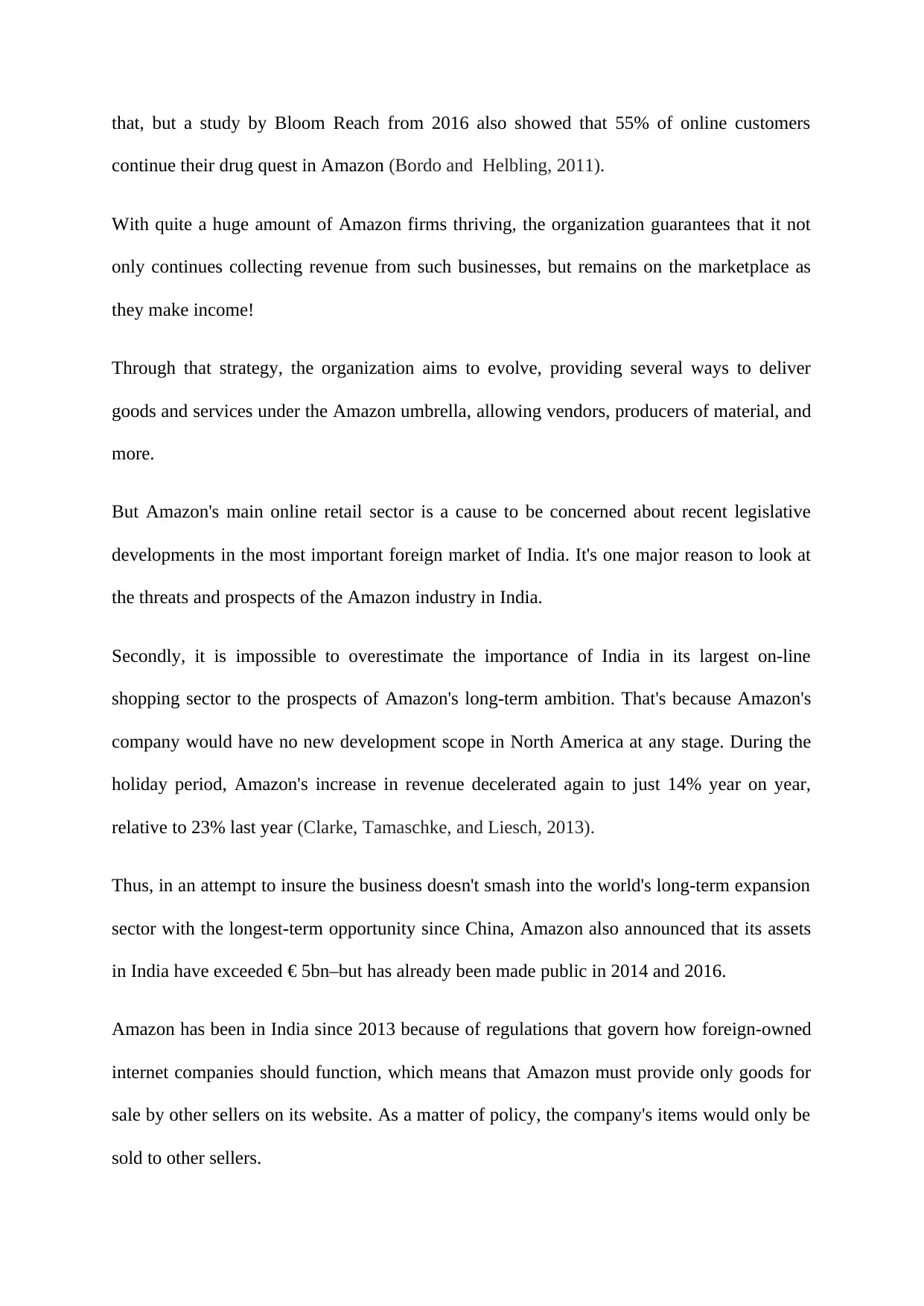
that, but a study by Bloom Reach from 2016 also showed that 55% of online customers
continue their drug quest in Amazon (Bordo and Helbling, 2011).
With quite a huge amount of Amazon firms thriving, the organization guarantees that it not
only continues collecting revenue from such businesses, but remains on the marketplace as
they make income!
Through that strategy, the organization aims to evolve, providing several ways to deliver
goods and services under the Amazon umbrella, allowing vendors, producers of material, and
more.
But Amazon's main online retail sector is a cause to be concerned about recent legislative
developments in the most important foreign market of India. It's one major reason to look at
the threats and prospects of the Amazon industry in India.
Secondly, it is impossible to overestimate the importance of India in its largest on-line
shopping sector to the prospects of Amazon's long-term ambition. That's because Amazon's
company would have no new development scope in North America at any stage. During the
holiday period, Amazon's increase in revenue decelerated again to just 14% year on year,
relative to 23% last year (Clarke, Tamaschke, and Liesch, 2013).
Thus, in an attempt to insure the business doesn't smash into the world's long-term expansion
sector with the longest-term opportunity since China, Amazon also announced that its assets
in India have exceeded € 5bn–but has already been made public in 2014 and 2016.
Amazon has been in India since 2013 because of regulations that govern how foreign-owned
internet companies should function, which means that Amazon must provide only goods for
sale by other sellers on its website. As a matter of policy, the company's items would only be
sold to other sellers.
continue their drug quest in Amazon (Bordo and Helbling, 2011).
With quite a huge amount of Amazon firms thriving, the organization guarantees that it not
only continues collecting revenue from such businesses, but remains on the marketplace as
they make income!
Through that strategy, the organization aims to evolve, providing several ways to deliver
goods and services under the Amazon umbrella, allowing vendors, producers of material, and
more.
But Amazon's main online retail sector is a cause to be concerned about recent legislative
developments in the most important foreign market of India. It's one major reason to look at
the threats and prospects of the Amazon industry in India.
Secondly, it is impossible to overestimate the importance of India in its largest on-line
shopping sector to the prospects of Amazon's long-term ambition. That's because Amazon's
company would have no new development scope in North America at any stage. During the
holiday period, Amazon's increase in revenue decelerated again to just 14% year on year,
relative to 23% last year (Clarke, Tamaschke, and Liesch, 2013).
Thus, in an attempt to insure the business doesn't smash into the world's long-term expansion
sector with the longest-term opportunity since China, Amazon also announced that its assets
in India have exceeded € 5bn–but has already been made public in 2014 and 2016.
Amazon has been in India since 2013 because of regulations that govern how foreign-owned
internet companies should function, which means that Amazon must provide only goods for
sale by other sellers on its website. As a matter of policy, the company's items would only be
sold to other sellers.

Worldwide, Amazon markets 48 percent of all physical goods. In India this figure was small.
However in supplying products by massive online retailers with equity interest Amazon has
circumvented these laws. The challenge is that this activity was already banned by new
legislation last week (Picciotto, 2017).
The new Indian rules also limit the availability of exclusive Indian e-commerce sites from
labels to just one domain. Like in the past, Amazon will still not be willing to deliver large
prices for items.
Amazon's biggest competitor in the world, the Walmart Flipkart, would, on Thursday, be
impacted by Arvind Singhal, a consultant to Technopak Advisors Pvt, who told Bloomberg
that he predicted "the sales growth of Amazon may be reduced to 15% in the coming months
by 25 to 30% earlier."
Brian Olsavsky, Chief Financial Officer of Amazon, seemed worried about Amazon's profits
for both journalists and investors on Thursday. [The effect on the e-commerce market of the
reform in government regulations there is a great deal in confusion, "he told analysts in a call
transcript. On a call from the media, Amazon said it should obey guidelines, but he stressed
that the laws are not conducive to how the business wants to work best. Again, when it is
interested, Amazon does not allow this stuff (Fletcher and Plakoyiannaki, 2011).
It would not be so necessary to move in India if Amazons big e-commerce company in other
areas of the world expanded rapidly— but that's not the case. Amazon's foreign sector has
only risen by 15% annually, so as a consequence of these reforms, this figure will decrease
dramatically.
Amazon provides its Indians free shipping and one-or two-day shipping, as well as exposure
to AMAZON Music and AMV, which seem to catch the attention of many Indians, given the
However in supplying products by massive online retailers with equity interest Amazon has
circumvented these laws. The challenge is that this activity was already banned by new
legislation last week (Picciotto, 2017).
The new Indian rules also limit the availability of exclusive Indian e-commerce sites from
labels to just one domain. Like in the past, Amazon will still not be willing to deliver large
prices for items.
Amazon's biggest competitor in the world, the Walmart Flipkart, would, on Thursday, be
impacted by Arvind Singhal, a consultant to Technopak Advisors Pvt, who told Bloomberg
that he predicted "the sales growth of Amazon may be reduced to 15% in the coming months
by 25 to 30% earlier."
Brian Olsavsky, Chief Financial Officer of Amazon, seemed worried about Amazon's profits
for both journalists and investors on Thursday. [The effect on the e-commerce market of the
reform in government regulations there is a great deal in confusion, "he told analysts in a call
transcript. On a call from the media, Amazon said it should obey guidelines, but he stressed
that the laws are not conducive to how the business wants to work best. Again, when it is
interested, Amazon does not allow this stuff (Fletcher and Plakoyiannaki, 2011).
It would not be so necessary to move in India if Amazons big e-commerce company in other
areas of the world expanded rapidly— but that's not the case. Amazon's foreign sector has
only risen by 15% annually, so as a consequence of these reforms, this figure will decrease
dramatically.
Amazon provides its Indians free shipping and one-or two-day shipping, as well as exposure
to AMAZON Music and AMV, which seem to catch the attention of many Indians, given the
⊘ This is a preview!⊘
Do you want full access?
Subscribe today to unlock all pages.

Trusted by 1+ million students worldwide
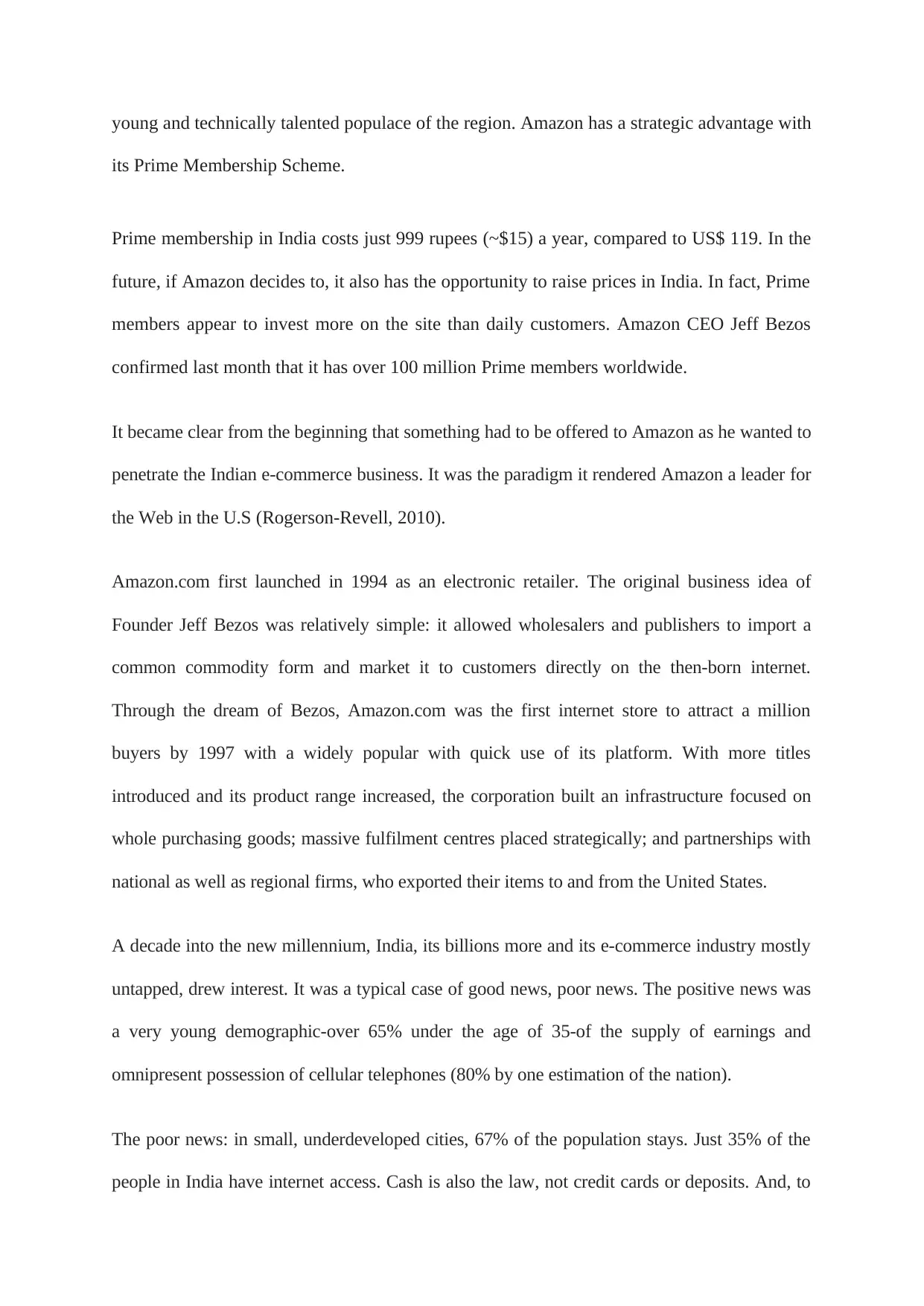
young and technically talented populace of the region. Amazon has a strategic advantage with
its Prime Membership Scheme.
Prime membership in India costs just 999 rupees (~$15) a year, compared to US$ 119. In the
future, if Amazon decides to, it also has the opportunity to raise prices in India. In fact, Prime
members appear to invest more on the site than daily customers. Amazon CEO Jeff Bezos
confirmed last month that it has over 100 million Prime members worldwide.
It became clear from the beginning that something had to be offered to Amazon as he wanted to
penetrate the Indian e-commerce business. It was the paradigm it rendered Amazon a leader for
the Web in the U.S (Rogerson-Revell, 2010).
Amazon.com first launched in 1994 as an electronic retailer. The original business idea of
Founder Jeff Bezos was relatively simple: it allowed wholesalers and publishers to import a
common commodity form and market it to customers directly on the then-born internet.
Through the dream of Bezos, Amazon.com was the first internet store to attract a million
buyers by 1997 with a widely popular with quick use of its platform. With more titles
introduced and its product range increased, the corporation built an infrastructure focused on
whole purchasing goods; massive fulfilment centres placed strategically; and partnerships with
national as well as regional firms, who exported their items to and from the United States.
A decade into the new millennium, India, its billions more and its e-commerce industry mostly
untapped, drew interest. It was a typical case of good news, poor news. The positive news was
a very young demographic-over 65% under the age of 35-of the supply of earnings and
omnipresent possession of cellular telephones (80% by one estimation of the nation).
The poor news: in small, underdeveloped cities, 67% of the population stays. Just 35% of the
people in India have internet access. Cash is also the law, not credit cards or deposits. And, to
its Prime Membership Scheme.
Prime membership in India costs just 999 rupees (~$15) a year, compared to US$ 119. In the
future, if Amazon decides to, it also has the opportunity to raise prices in India. In fact, Prime
members appear to invest more on the site than daily customers. Amazon CEO Jeff Bezos
confirmed last month that it has over 100 million Prime members worldwide.
It became clear from the beginning that something had to be offered to Amazon as he wanted to
penetrate the Indian e-commerce business. It was the paradigm it rendered Amazon a leader for
the Web in the U.S (Rogerson-Revell, 2010).
Amazon.com first launched in 1994 as an electronic retailer. The original business idea of
Founder Jeff Bezos was relatively simple: it allowed wholesalers and publishers to import a
common commodity form and market it to customers directly on the then-born internet.
Through the dream of Bezos, Amazon.com was the first internet store to attract a million
buyers by 1997 with a widely popular with quick use of its platform. With more titles
introduced and its product range increased, the corporation built an infrastructure focused on
whole purchasing goods; massive fulfilment centres placed strategically; and partnerships with
national as well as regional firms, who exported their items to and from the United States.
A decade into the new millennium, India, its billions more and its e-commerce industry mostly
untapped, drew interest. It was a typical case of good news, poor news. The positive news was
a very young demographic-over 65% under the age of 35-of the supply of earnings and
omnipresent possession of cellular telephones (80% by one estimation of the nation).
The poor news: in small, underdeveloped cities, 67% of the population stays. Just 35% of the
people in India have internet access. Cash is also the law, not credit cards or deposits. And, to
Paraphrase This Document
Need a fresh take? Get an instant paraphrase of this document with our AI Paraphraser

protect its own, India has adopted a stringent FDI policy which restricts foreign multibrand
distributors from direct online sales to consumers. In theory, this implied that every company
was a third-party retailer of Indian goods. Challenges, possibly even hurdles, for Amazon, but
not insurmountable ones — they just required an innovative business model, beginning with
finding products to sell (Gertsen, and Søderberg, 2011).
Goods created by Indians are not in need, but the majority of the country's sellers are tiny.
Relatively few vendors marketed their goods digitally three years ago because they claimed
that e-commerce was too complicated and time consuming. The cash system in India hasn't
made electronic transfers simpler.
Amazon built a plan to promote and persuade the industry that it was a trustworthy
collaboration that could allow the demand for merchandise to grow in 2013, to respond to
certain problems since the launch of the Indian web site in 2013. Amazón introduced an
Amazon Chai Cart programme: mobile tea carts that traveled the city streets to support small
business owners refreshments while showing them the principles of e-commerce. Reportedly,
the Chai Cart team has driven more than 9.400 miles across 31 cities and supported over 10,000
vendors. Last year, Amazon founded Amazon Tatkal, a self-defined "path workshop," which
provides a variety of launch resources such as registration, modeling, cataloging and selling
training for these vendors in order to help them move online faster and resolve their objections
to e-commerce (Karabarbounis, 2014).
But the distribution and output had to be tailored even to Amazon. In the USA, Amazon uses a
centrally controlled distribution network to store and deliver the items it offers, named Amazon
Fulfillment (FBA). Sellers bring the products into the fulfillment centers of Amazon and pay
the business a charge to stock, purchase, prepare and mail. Amazon has also introduced FBA in
distributors from direct online sales to consumers. In theory, this implied that every company
was a third-party retailer of Indian goods. Challenges, possibly even hurdles, for Amazon, but
not insurmountable ones — they just required an innovative business model, beginning with
finding products to sell (Gertsen, and Søderberg, 2011).
Goods created by Indians are not in need, but the majority of the country's sellers are tiny.
Relatively few vendors marketed their goods digitally three years ago because they claimed
that e-commerce was too complicated and time consuming. The cash system in India hasn't
made electronic transfers simpler.
Amazon built a plan to promote and persuade the industry that it was a trustworthy
collaboration that could allow the demand for merchandise to grow in 2013, to respond to
certain problems since the launch of the Indian web site in 2013. Amazón introduced an
Amazon Chai Cart programme: mobile tea carts that traveled the city streets to support small
business owners refreshments while showing them the principles of e-commerce. Reportedly,
the Chai Cart team has driven more than 9.400 miles across 31 cities and supported over 10,000
vendors. Last year, Amazon founded Amazon Tatkal, a self-defined "path workshop," which
provides a variety of launch resources such as registration, modeling, cataloging and selling
training for these vendors in order to help them move online faster and resolve their objections
to e-commerce (Karabarbounis, 2014).
But the distribution and output had to be tailored even to Amazon. In the USA, Amazon uses a
centrally controlled distribution network to store and deliver the items it offers, named Amazon
Fulfillment (FBA). Sellers bring the products into the fulfillment centers of Amazon and pay
the business a charge to stock, purchase, prepare and mail. Amazon has also introduced FBA in
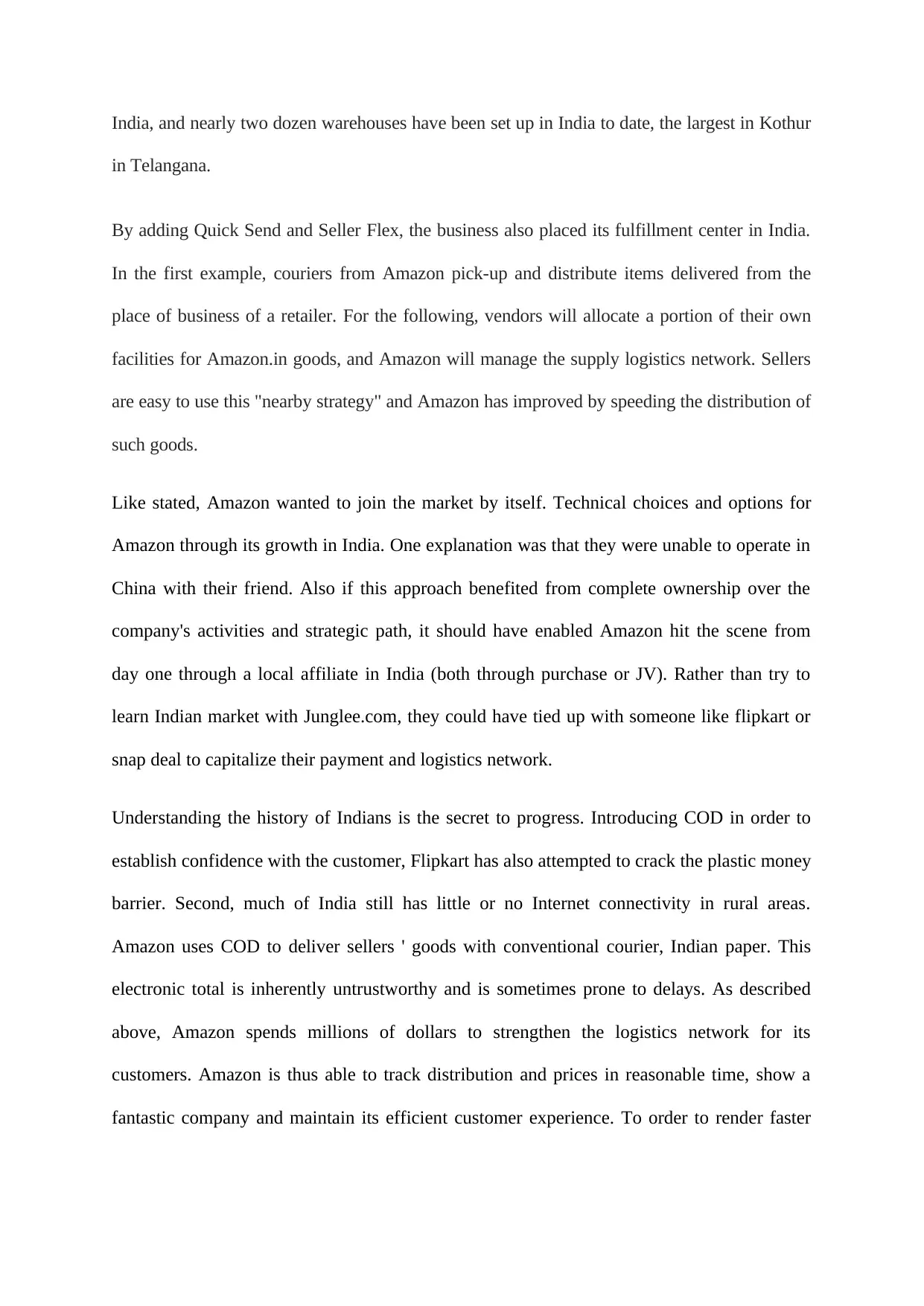
India, and nearly two dozen warehouses have been set up in India to date, the largest in Kothur
in Telangana.
By adding Quick Send and Seller Flex, the business also placed its fulfillment center in India.
In the first example, couriers from Amazon pick-up and distribute items delivered from the
place of business of a retailer. For the following, vendors will allocate a portion of their own
facilities for Amazon.in goods, and Amazon will manage the supply logistics network. Sellers
are easy to use this "nearby strategy" and Amazon has improved by speeding the distribution of
such goods.
Like stated, Amazon wanted to join the market by itself. Technical choices and options for
Amazon through its growth in India. One explanation was that they were unable to operate in
China with their friend. Also if this approach benefited from complete ownership over the
company's activities and strategic path, it should have enabled Amazon hit the scene from
day one through a local affiliate in India (both through purchase or JV). Rather than try to
learn Indian market with Junglee.com, they could have tied up with someone like flipkart or
snap deal to capitalize their payment and logistics network.
Understanding the history of Indians is the secret to progress. Introducing COD in order to
establish confidence with the customer, Flipkart has also attempted to crack the plastic money
barrier. Second, much of India still has little or no Internet connectivity in rural areas.
Amazon uses COD to deliver sellers ' goods with conventional courier, Indian paper. This
electronic total is inherently untrustworthy and is sometimes prone to delays. As described
above, Amazon spends millions of dollars to strengthen the logistics network for its
customers. Amazon is thus able to track distribution and prices in reasonable time, show a
fantastic company and maintain its efficient customer experience. To order to render faster
in Telangana.
By adding Quick Send and Seller Flex, the business also placed its fulfillment center in India.
In the first example, couriers from Amazon pick-up and distribute items delivered from the
place of business of a retailer. For the following, vendors will allocate a portion of their own
facilities for Amazon.in goods, and Amazon will manage the supply logistics network. Sellers
are easy to use this "nearby strategy" and Amazon has improved by speeding the distribution of
such goods.
Like stated, Amazon wanted to join the market by itself. Technical choices and options for
Amazon through its growth in India. One explanation was that they were unable to operate in
China with their friend. Also if this approach benefited from complete ownership over the
company's activities and strategic path, it should have enabled Amazon hit the scene from
day one through a local affiliate in India (both through purchase or JV). Rather than try to
learn Indian market with Junglee.com, they could have tied up with someone like flipkart or
snap deal to capitalize their payment and logistics network.
Understanding the history of Indians is the secret to progress. Introducing COD in order to
establish confidence with the customer, Flipkart has also attempted to crack the plastic money
barrier. Second, much of India still has little or no Internet connectivity in rural areas.
Amazon uses COD to deliver sellers ' goods with conventional courier, Indian paper. This
electronic total is inherently untrustworthy and is sometimes prone to delays. As described
above, Amazon spends millions of dollars to strengthen the logistics network for its
customers. Amazon is thus able to track distribution and prices in reasonable time, show a
fantastic company and maintain its efficient customer experience. To order to render faster
⊘ This is a preview!⊘
Do you want full access?
Subscribe today to unlock all pages.

Trusted by 1+ million students worldwide
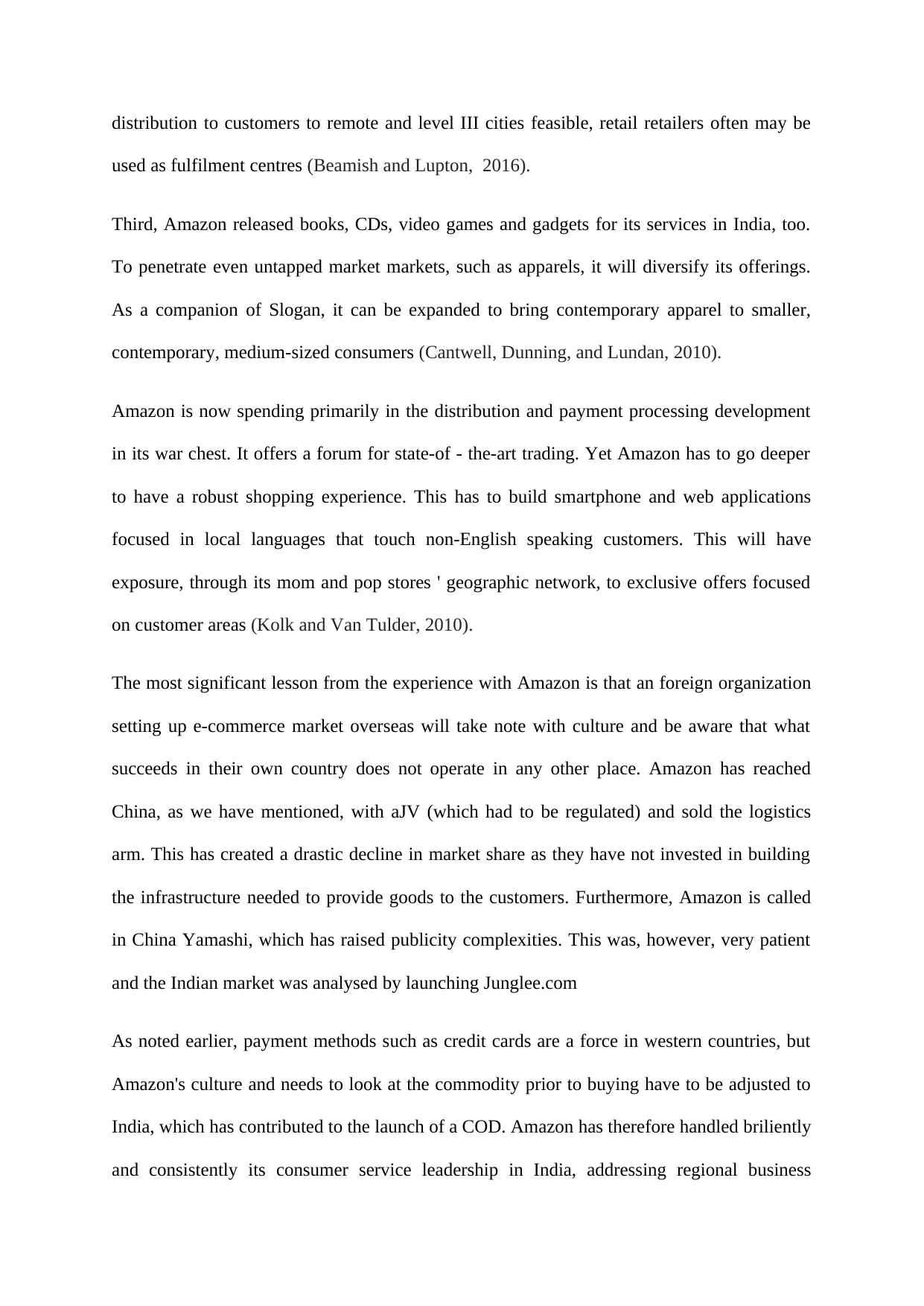
distribution to customers to remote and level III cities feasible, retail retailers often may be
used as fulfilment centres (Beamish and Lupton, 2016).
Third, Amazon released books, CDs, video games and gadgets for its services in India, too.
To penetrate even untapped market markets, such as apparels, it will diversify its offerings.
As a companion of Slogan, it can be expanded to bring contemporary apparel to smaller,
contemporary, medium-sized consumers (Cantwell, Dunning, and Lundan, 2010).
Amazon is now spending primarily in the distribution and payment processing development
in its war chest. It offers a forum for state-of - the-art trading. Yet Amazon has to go deeper
to have a robust shopping experience. This has to build smartphone and web applications
focused in local languages that touch non-English speaking customers. This will have
exposure, through its mom and pop stores ' geographic network, to exclusive offers focused
on customer areas (Kolk and Van Tulder, 2010).
The most significant lesson from the experience with Amazon is that an foreign organization
setting up e-commerce market overseas will take note with culture and be aware that what
succeeds in their own country does not operate in any other place. Amazon has reached
China, as we have mentioned, with aJV (which had to be regulated) and sold the logistics
arm. This has created a drastic decline in market share as they have not invested in building
the infrastructure needed to provide goods to the customers. Furthermore, Amazon is called
in China Yamashi, which has raised publicity complexities. This was, however, very patient
and the Indian market was analysed by launching Junglee.com
As noted earlier, payment methods such as credit cards are a force in western countries, but
Amazon's culture and needs to look at the commodity prior to buying have to be adjusted to
India, which has contributed to the launch of a COD. Amazon has therefore handled briliently
and consistently its consumer service leadership in India, addressing regional business
used as fulfilment centres (Beamish and Lupton, 2016).
Third, Amazon released books, CDs, video games and gadgets for its services in India, too.
To penetrate even untapped market markets, such as apparels, it will diversify its offerings.
As a companion of Slogan, it can be expanded to bring contemporary apparel to smaller,
contemporary, medium-sized consumers (Cantwell, Dunning, and Lundan, 2010).
Amazon is now spending primarily in the distribution and payment processing development
in its war chest. It offers a forum for state-of - the-art trading. Yet Amazon has to go deeper
to have a robust shopping experience. This has to build smartphone and web applications
focused in local languages that touch non-English speaking customers. This will have
exposure, through its mom and pop stores ' geographic network, to exclusive offers focused
on customer areas (Kolk and Van Tulder, 2010).
The most significant lesson from the experience with Amazon is that an foreign organization
setting up e-commerce market overseas will take note with culture and be aware that what
succeeds in their own country does not operate in any other place. Amazon has reached
China, as we have mentioned, with aJV (which had to be regulated) and sold the logistics
arm. This has created a drastic decline in market share as they have not invested in building
the infrastructure needed to provide goods to the customers. Furthermore, Amazon is called
in China Yamashi, which has raised publicity complexities. This was, however, very patient
and the Indian market was analysed by launching Junglee.com
As noted earlier, payment methods such as credit cards are a force in western countries, but
Amazon's culture and needs to look at the commodity prior to buying have to be adjusted to
India, which has contributed to the launch of a COD. Amazon has therefore handled briliently
and consistently its consumer service leadership in India, addressing regional business
Paraphrase This Document
Need a fresh take? Get an instant paraphrase of this document with our AI Paraphraser

climate issues such as history, logistics, domestic economies, legislation and regional
domestic dilemmas (Doz, 2011).
REFERENCES
Baughn, C., Bodie, N.L., Buchanan, M.A. and Bixby, M.B., 2010. Bribery in international
business transactions. Journal of Business Ethics, 92(1), pp.15-32.
Beamish, P.W. and Lupton, N.C., 2016. Cooperative strategies in international business and
management: Reflections on the past 50 years and future directions. Journal of World
Business, 51(1), pp.163-175.
Bordo, M. D., and Helbling, T. F. (2011). International business cycle synchronization in
historical perspective. The Manchester School, 79(2), 208-238.
Cantwell, J., Dunning, J.H. and Lundan, S.M., 2010. An evolutionary approach to
understanding international business activity: The co-evolution of MNEs and the institutional
environment. Journal of International Business Studies, 41(4), pp.567-586.
Clarke, J.E., Tamaschke, R. and Liesch, P.W., 2013. International experience in international
business research: A conceptualization and exploration of key themes. International Journal
of Management Reviews, 15(3), pp.265-279.
Doz, Y., 2011. Qualitative research for international business. Journal of International
Business Studies, 42(5), pp.582-590.
Fletcher, M. and Plakoyiannaki, E., 2011. 10. Case selection in international business: key
issues and common misconceptions. Rethinking the case study in international business and
management research, 171.
domestic dilemmas (Doz, 2011).
REFERENCES
Baughn, C., Bodie, N.L., Buchanan, M.A. and Bixby, M.B., 2010. Bribery in international
business transactions. Journal of Business Ethics, 92(1), pp.15-32.
Beamish, P.W. and Lupton, N.C., 2016. Cooperative strategies in international business and
management: Reflections on the past 50 years and future directions. Journal of World
Business, 51(1), pp.163-175.
Bordo, M. D., and Helbling, T. F. (2011). International business cycle synchronization in
historical perspective. The Manchester School, 79(2), 208-238.
Cantwell, J., Dunning, J.H. and Lundan, S.M., 2010. An evolutionary approach to
understanding international business activity: The co-evolution of MNEs and the institutional
environment. Journal of International Business Studies, 41(4), pp.567-586.
Clarke, J.E., Tamaschke, R. and Liesch, P.W., 2013. International experience in international
business research: A conceptualization and exploration of key themes. International Journal
of Management Reviews, 15(3), pp.265-279.
Doz, Y., 2011. Qualitative research for international business. Journal of International
Business Studies, 42(5), pp.582-590.
Fletcher, M. and Plakoyiannaki, E., 2011. 10. Case selection in international business: key
issues and common misconceptions. Rethinking the case study in international business and
management research, 171.
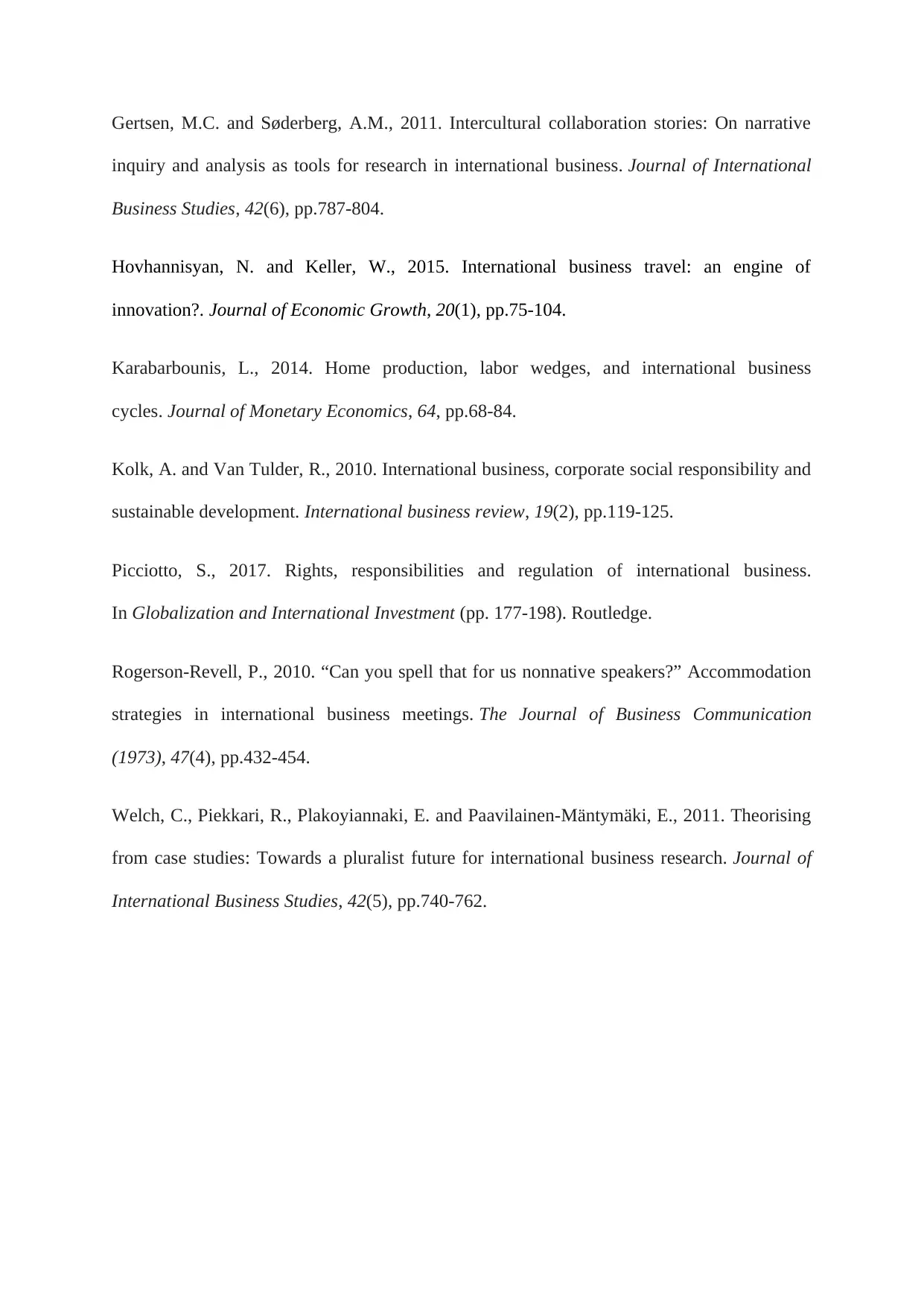
Gertsen, M.C. and Søderberg, A.M., 2011. Intercultural collaboration stories: On narrative
inquiry and analysis as tools for research in international business. Journal of International
Business Studies, 42(6), pp.787-804.
Hovhannisyan, N. and Keller, W., 2015. International business travel: an engine of
innovation?. Journal of Economic Growth, 20(1), pp.75-104.
Karabarbounis, L., 2014. Home production, labor wedges, and international business
cycles. Journal of Monetary Economics, 64, pp.68-84.
Kolk, A. and Van Tulder, R., 2010. International business, corporate social responsibility and
sustainable development. International business review, 19(2), pp.119-125.
Picciotto, S., 2017. Rights, responsibilities and regulation of international business.
In Globalization and International Investment (pp. 177-198). Routledge.
Rogerson-Revell, P., 2010. “Can you spell that for us nonnative speakers?” Accommodation
strategies in international business meetings. The Journal of Business Communication
(1973), 47(4), pp.432-454.
Welch, C., Piekkari, R., Plakoyiannaki, E. and Paavilainen-Mäntymäki, E., 2011. Theorising
from case studies: Towards a pluralist future for international business research. Journal of
International Business Studies, 42(5), pp.740-762.
inquiry and analysis as tools for research in international business. Journal of International
Business Studies, 42(6), pp.787-804.
Hovhannisyan, N. and Keller, W., 2015. International business travel: an engine of
innovation?. Journal of Economic Growth, 20(1), pp.75-104.
Karabarbounis, L., 2014. Home production, labor wedges, and international business
cycles. Journal of Monetary Economics, 64, pp.68-84.
Kolk, A. and Van Tulder, R., 2010. International business, corporate social responsibility and
sustainable development. International business review, 19(2), pp.119-125.
Picciotto, S., 2017. Rights, responsibilities and regulation of international business.
In Globalization and International Investment (pp. 177-198). Routledge.
Rogerson-Revell, P., 2010. “Can you spell that for us nonnative speakers?” Accommodation
strategies in international business meetings. The Journal of Business Communication
(1973), 47(4), pp.432-454.
Welch, C., Piekkari, R., Plakoyiannaki, E. and Paavilainen-Mäntymäki, E., 2011. Theorising
from case studies: Towards a pluralist future for international business research. Journal of
International Business Studies, 42(5), pp.740-762.
⊘ This is a preview!⊘
Do you want full access?
Subscribe today to unlock all pages.

Trusted by 1+ million students worldwide
1 out of 12
Related Documents
Your All-in-One AI-Powered Toolkit for Academic Success.
+13062052269
info@desklib.com
Available 24*7 on WhatsApp / Email
![[object Object]](/_next/static/media/star-bottom.7253800d.svg)
Unlock your academic potential
Copyright © 2020–2025 A2Z Services. All Rights Reserved. Developed and managed by ZUCOL.





